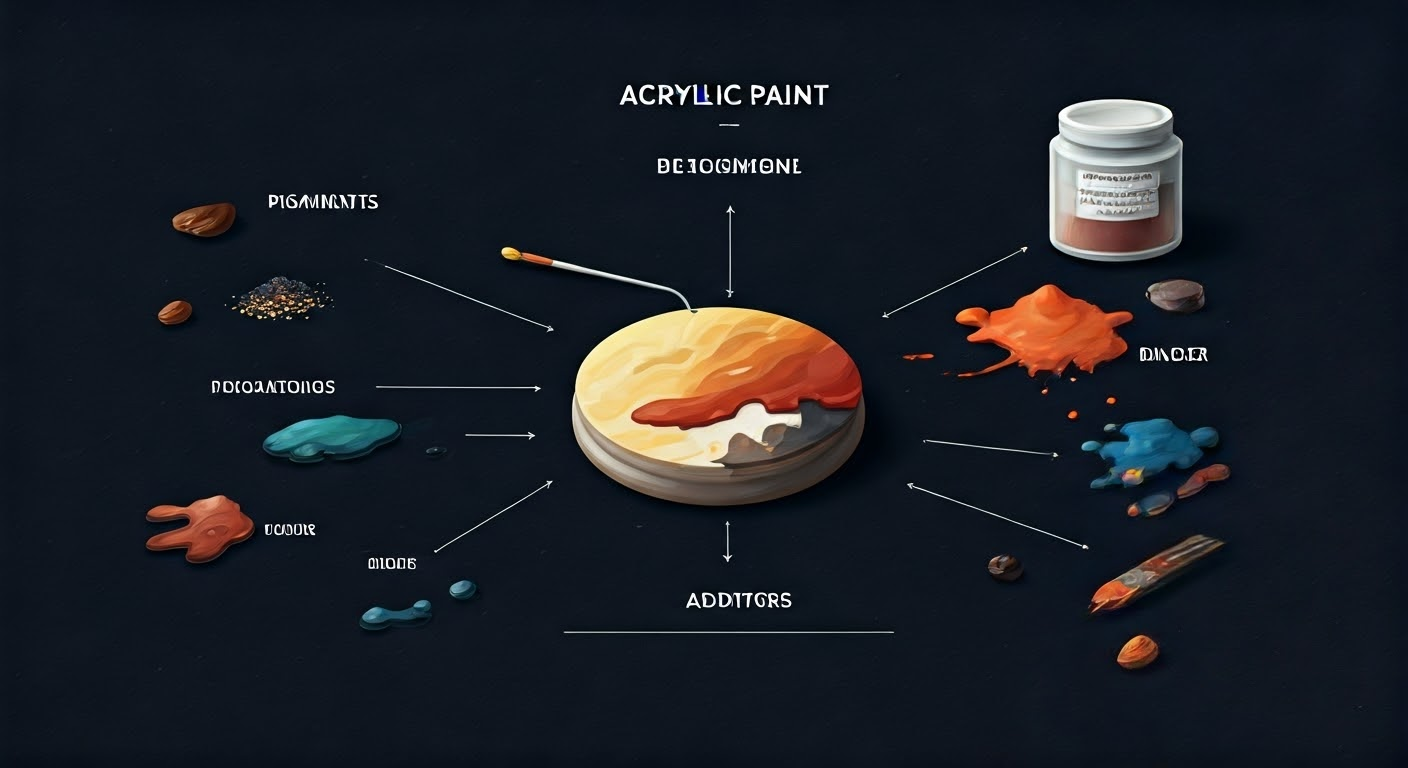
Acrylic paint is known for its versatility and user-friendly nature. But what happens when you make a mistake? Don’t worry–one of the many advantages of acrylic paint is its ability to be painted over.
Whether you’re covering up a small error or completely changing your composition, applying fresh acrylic paint over existing layers is a perfectly good idea and often a part of the creative process.
Flexibility of Acrylic Paints

Unlike their oil-based counterparts, acrylic paints are renowned for their quick drying times and water-based composition. This means artists can layer colors efficiently without waiting extended periods. But how does this relate to painting over errors?
The fast-drying nature of acrylics creates a forgiving medium for 수정. As the paint dries quickly, it forms a stable layer, allowing you to apply new paint on top without lifting or reactivating the previous layer. This flexibility allows for experimentation and adjustments as you paint.
You Can Read: Can You Use a Fan for Quick Drying of Acrylic Pour Painting?
Acrylic Paint Composition
To appreciate why acrylic paints work so well for overpainting, it helps to understand their basic composition. Acrylic paint consists of three main components: pigment, binder, and solvent.
Pigments provide the color, while the binder, in this case, acrylic polymer emulsion, holds the pigment to the painting surface. The solvent, typically water, adjusts the paint’s consistency and evaporates as the paint dries.
This unique blend gives acrylic paint its quick-drying and layerable qualities, making it an excellent choice for both beginners and seasoned artists looking to correct mistakes and achieve stunning results.
How Drying Times Affect Repainting
Understanding the drying time of acrylic paint is essential when it comes to painting over it. While acrylics dry quickly on the surface, allowing for layering within minutes, complete drying can take longer, usually up to 24 hours depending on the thickness of the application.
If you attempt to paint over wet paint, you risk blending the colors unintentionally and creating a muddy effect. On the other hand, working on a completely dry surface ensures that your new layer stays true to its intended color and texture.
For best results when overpainting, it’s advisable to apply your corrections in thin layers, allowing for better adhesion and minimizing the risk of cracking. Additionally, being mindful of drying times allows you to control the blending and layering effects, achieving the desired outcome.
Step-by-Step Guide to Painting Over Acrylics

Before you start painting over an “oops,” there are a couple of steps to maximize your chances of success.
Let’s break down the process of painting over acrylics into easy-to-follow steps to ensure a flawless finish.
Preparation Steps for Overpainting
- Clean the surface: Begin by gently cleaning the canvas painting with a soft, damp cloth to remove any dust or debris. Allow the surface to dry completely before proceeding. This ensures that the new paint adheres properly and does not trap any impurities, leading to a smoother final result.
- Assess the surface: If the existing paint is notably textured, consider lightly sanding the area with fine-grit sandpaper, creating a more even surface for the new paint.
- Consider an isolation coat: For significant color changes or if you are unsure about the compatibility of different acrylic brands, applying an isolation coat is a good practice. An isolation coat acts as a barrier, preventing the old paint from bleeding through.
Techniques for Covering Up Mistakes
- Load your palette: Squeeze out a generous amount of new paint onto your palette, ensuring you have enough to cover the mistake completely.
- Apply the new paint: Using a clean brush or palette knife, depending on the desired effect, apply an even layer of the new paint over the area you wish to correct.
- Blending and layering: If you are aiming for a seamless blend, use gentle brush strokes to feather the edges of the new paint into the surrounding area. If you need to build up the opacity, allow each layer to dry thoroughly before applying the next.
Conclusion
painting over the wrong acrylic color is possible with the right techniques. Understanding the flexibility of acrylic paints and how drying times affect repainting is crucial.
By following a step-by-step guide, including proper preparation and covering techniques, you can correct mistakes seamlessly. Remember, patience is key, especially when waiting for layers to dry before repainting.
With practice and knowledge, you can achieve the desired results. Embrace the versatility of acrylic paints and don’t be afraid to experiment to create your masterpiece.
CTA: Explore more acrylic painting tips and tricks for your next project!
Frequently Asked Questions
Can I paint over acrylic paint that’s still wet?
While you can, it’s not always a good idea. Painting over wet paint will blend colors, which is not always a bad thing. However, too many thick paints on top of each other can lead to cracking, so if you need to cover a large area, let the first layer dry before you paint over it. If you have excess paint, you can lightly scrape it off and let the whole thing dry before you try to fix the mistake.
How do I fix a painting mistake without ruining the canvas?
If you’ve made a mistake with acrylic painting, don’t panic! As long as you haven’t used too much water, it’s often as simple as letting the paint dry completely and then painting over it. If the paint is still wet, you can try to gently lift away excess paint with a wet brush, taking care not to disrupt the rest of the painting.
What should I do if the new color doesn’t cover the old one completely?
If you don’t use enough paint, the old color might still show through. Apply thin coats of titanium white, letting each layer dry before applying the next. The most important thing is to ensure a consistent and opaque layer of acrylic, and if needed, a final varnish can also help to even out the appearance.
Are there any colors that are harder to cover than others?
Darker colors or those with strong pigments might require multiple coats to achieve full coverage. This is where the amount of water comes in. If you’re painting the whole canvas over to correct acrylic paint mistakes, you can use a little bit of water to thin your new paint.
How long should I wait before repainting over an acrylic painting?
It depends on the thickness of the paint, but it’s always best to err on the side of caution. Even if it feels dry to the touch, acrylic paint may still be a little bit tacky underneath. Unlike oil painting, the best way to ensure a smooth, blended finish is to wait for the paint to dry completely, which can take up to 24 hours or more, especially for thick layers.
